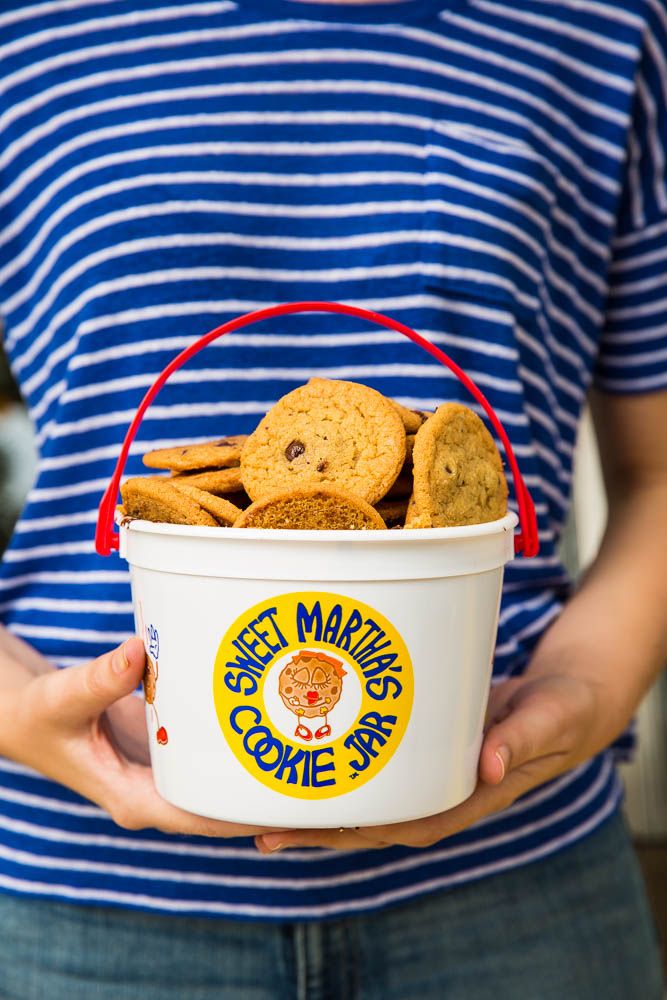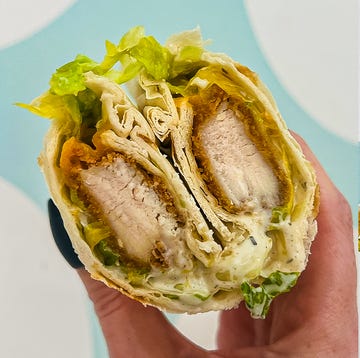Maybe it's the yellow Sweet Martha's t-shirt with the cookie jar on it, and that signature dark brown bob. Or maybe it's the video camera pointed at her face. But within seconds of standing in front of her stand at the Minnesota State Fair, people are whispering about Martha Rossini Olson.
"Um, excuse me, are you the Sweet Martha?" a man asks, cell phone at the ready. "Would you mind taking a picture with our son?"
Olson's grin widens as she kneels to pose next to the toddler's stroller. She doesn't consider herself a celebrity by any means, but to anyone who's been to these fairgrounds in the last 30 years, she's Taylor Swift (pre-Kimye Snapchat drama, of course).
The St. Paul native has made a name for herself selling one thing—and one thing only: chocolate chip cookies. Last year, Sweet Martha's Cookie Jar brought in $3 million over the fair's 12-day run, a figure the company may very well surpass this year, now that it's expanded from two stands to three. The original two outsell every other vendor there, which flies in the face of everything you'd expect to be successful at such a festival. Namely, they're not deep-fried or served on a stick.
"All the time, people will say, 'you know, I really like
oatmeal,' and I say, 'you know, I do too—we actually have those in
grocery stores [as frozen dough], but we can hardly handle just chocolate
chip,'" Olson explains. "That's the truth. We cannot give people more
than one choice, because our lines get so long, so this just works out better
for us."
Focusing on chocolate chip allows Sweet Martha's Cookie Jar to hit on that economic sweet spot: Economies of scale. Every aspect of the business has been meticulously planned to bake as many cookies as possible, as quickly as possible. When Sweet Martha's started back in 1979, they prided themselves on baking 200 cookies in 12 minutes. Today, they average about 30,000 during that time frame.
One look inside the kitchen—or through the "Watch Us Bake 'Em" window on the side of the shop—underscores that obsession with efficiency. Large stand mixers are positioned right next to two Cookie Kings—behemoth machines that let you dump cookie dough into a funnel. These machines churn out identically portioned scoops of cookie dough directly onto parchment-lined baking sheets, which employees load onto racks.
Once a rack is full, it's wheeled to the ovens nearby. Once they've been baked, the cookies are given a few minutes to cool—they're served warm, not scorch-your-tongue-hot—then they're ready to sell. There's no transferring the cookies from baking sheet to fancy display platters, like you'd see in a typical bakery; the lines are too long for that sort of dilly-dallying. Instead, baking sheets are plunked right in the windows for customers to see, as a row of employees use wide-mouthed scoops to funnel the palm-sized cookies into cups and plastic pails.
Even at 9:30 a.m. on a Friday morning, with 28 servers manning the registers at the grandstand location, the lines were 5 to 6 people deep. This quickly turned into a mob scene by late afternoon. And that's after adding the third location at the north end of the park to aid in crowd control. As the rush sets in, it's one employee's job to replenish the plastic pails—which hold about 4 dozen cookies apiece. That way the cookie servers never have to pause to hunt down extra buckets—and you're never more than minutes away from a mountain of warm cookies.
She Never Intended to Get in the Cookie Biz.
Though Olson and her family have built an empire out of selling chocolate chip cookies, that was never part of her plan. She and her husband ran a frozen yogurt shop in downtown Minneapolis and dreamed of selling the treats at the fair. They applied for years, but weren't invited to open a stand until they mentioned the other product they sold—which, at the time, were Famous Amos chocolate chip cookies—and were asked to sell the baked goods.
"We said, 'sure,' then hung up the phone and went, 'Ahhhh! What do we do?'" Olson explains. "We had three weeks to put together a stand, so myself, my husband Gary, and Neil O'Leary—a high school partner and friend, who we've known forever—put together a stand in our backyard and rented all of the equipment."
During that same time, they tested their own family recipes for chocolate chip cookies, eventually landing on the chewy, soft-but-crisp-edged version they debuted at their first fair and still use to this day.
Throughout the years, the team invested heavily in Sweet Martha's Cookie Jar, putting all of the money they made each season back into the business so they could expand aggressively to keep up with demand. As interest—and their funds—increased, they moved to bigger, better locations at the fair, moving six times total before settling on their current spots.
Things really hit a turning point about 15 years ago, when Sweet Martha's opened its largest location, a custom-built shop to handle the massive amounts of foot traffic in the heart of the fair. (While Texas is often considered the largest state fair in the U.S., Minnesota's is open for a shorter timespan and has a larger daily attendance.
On Sept. 4, 233,303 people
crammed its streets, making it the second-busiest Sunday in fair history.)
"After [the grandstand location] opened, we started seeing bigger and bigger crowds, and that's when it really felt like we were onto something," Olson says.
At this point, production is so massive Sweet Martha's employs 550 people across its three stands during the 12-day period. During the rest of the year, the company scales back, taking on occasional events in the Twin Cities, where they sell chocolate chip cookies out of a small trailer. They also sell frozen cookie dough at Minnesota grocery stores.
"We wanted the cookies to be similar to the fair's—fresh out of the oven, and we didn't want to add preservatives—so that's why we did frozen dough instead of pre-baked cookies," she explains.
Warm cookies have been a crucial part of the business strategy—because who can resist a fresh-from-the-oven cookie, especially when it's just a short walk away from an All-You-Can-Drink milk bar? (which is actually a thing, thanks to the state's dairy association). Equally important, though, is the way the cookies are presented.
Packaging Is Key.
Even if the fair's streets are so congested you can't see more than five feet in front of you—which happens on weekends—you can still easily find Sweet Martha's. You could always scan the skies for the baking equivalent of a bat signal—Martha's winking animatronic cookies that hang above each shop—or you can follow the trail of smashed cookies.
Olson didn't intend to ever have a cookie down—she's passionate about not contributing to littering or messes at the fair—but given the signature way the treats are presented, it happens. Often.
Cookies are sold in two sizes: In a cone-shaped paper container, which holds about a dozen treats, or the massive plastic pail.
"We thought about selling them in a paper boat or a bag, but we wanted it to be something people had to hold, that other people would see," Olson says.
One of her early employees was a dancer, and while touring in New York City, saw cookies being sold in a cone. You couldn't tuck that into your purse, like you could a paper baggie. "I have that cone still," she says.
After people kept asking for larger sizes, Sweet Martha's introduced the take-home pail, deciding to wedge the lid between the handle and the edge of the bucket, so it could act as a backboard to pile up even more cookies, creating a towering display that would stand out in a sea of over-the-top fair foods.
She's Taking Traditional Treats to the Tech-Obsessed.
While chocolate chip cookies may seem old school—particularly at a fair that's selling deep-fried nachos and an Americanized take on Taiyaki, a fish-shaped cake stuffed with ice cream—Sweet Martha's edge comes from its forward-thinking marketing strategy.
In 2010, Sweet Martha's joined social media and launched a "Tale of the Pail" contest, asking people to show off how they use the plastic containers after the cookies are gone. (A few submissions: As a tool for building sandcastles, a home for Lego collections, even a first-aid kit for the car, according to MinnPost.) The whole competition highlighted Sweet Martha's savvy: Keep using the buckets, keep thinking about us until next year.
This year, the brand added a Snapchat filter, letting people frame their fair memories with Sweet Martha's cookie illustrations. That way, even if people aren't right in front of a shop, there's a trigger to make them think of grabbing a bucket. That, combined with a sense of scarcity—you can only get a bucket 12 days out of the year—and the nostalgia classic chocolate chip cookies evoke, make the brand a textbook example of marketing savvy. It's no wonder Sweet Martha's sells 1 million cookies a day.
"It's almost a rite of passage for people grabbing their cookies on the way home," State Fair License Administration Manager Dennis Larson told the Minneapolis-St. Paul Business Journal.
Like watching someone sculpt 90-pound blocks of butter into the face of the local dairy princess, or spending $47 to win a stuffed doll at the Whack-a-Mole booth in the Midway, it isn't the Minnesota State Fair without Sweet Martha.
Follow Delish on Instagram.



















